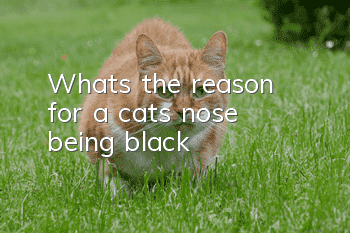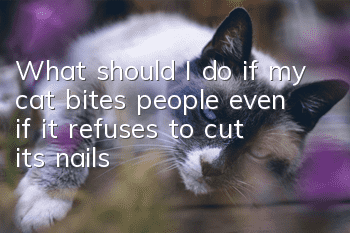What's the reason for a cat's nose being black?

A cat’s nose is dark because of endocrine disorders, which are also accompanied by symptoms of hair loss; a cat’s nose is dark because of acne, just wipe it slowly with a wet tissue; a cat’s nose is dark because of excessive ultraviolet rays, so avoid cats The exposure time is too long; the cat’s black nose is caused by pemphigus foliaceus and requires symptomatic treatment.
A black nose in a cat is due to endocrine disorders
Endocrine disorders in cats are also accompanied by symptoms of hair loss. Abnormal melanin metabolism in cats will cause melanin to be deposited in the cat’s nose, causing the cat’s nose to turn black. If you encounter this situation, you need to take the cat to the hospital for professional examination and symptomatic treatment.
A cat’s nose is dark because of “acne”
Cat acne is different from human acne. Hairy acne generally appears on the outside of a cat's nose and is black in color. Cat acne can be wiped away directly with a wet tissue, but scavengers should wipe it gently and slowly. The specific reason why cats suffer from this kind of feline acne is currently unknown, but it may be related to weather, diet, and endocrine.
What is the reason for a cat’s black nose
A black nose in a cat is caused by excessive exposure to ultraviolet rays
Cats are overly stimulated by sunlight or ultraviolet rays, which causes the cells in the nose to secrete various pigments that block sunlight, causing the cat's nose to be dark. Cats may like to bask in the sun next to the bed. Cats only care about the comfort of the sun and do not know that ultraviolet rays are so poisonous. Therefore, you should pay attention to avoid excessive exposure of ultraviolet rays to cats.
The cat’s nose is black because of pemphigus foliaceus.Pemphigus foliaceus is an autoimmune skin disease characterized by the production of autoantibodies that react with adhesion molecules on true polykeratinocytes. Cats suffering from this disease will lose weight, have pimple-like ulcers all over their body, and the skin on their nose will be chapped and then scabbed into black. For the treatment of pemphigus foliaceus, cephalexin 20 mg/kg twice a day, prednisone tablets 1 mg/kg twice a day, medicinal bath once every three days, and continuous treatment for three weeks. The above treatment plans are only for reference by those who have experience in medication. If you have no experience in medication, please seek medical treatment in time.
- How to prevent cats from scratching walls. Train cats not to scratch walls.
- What should you pay attention to after urethrostomy surgery in male blue cats?
- What to do if a cat is anorexic? Most cats can regain their appetite after treatment
- One of the few things cat owners must pay attention to is whether I can spank a cat. Attention cat owners!
- Why doesn’t anyone keep Selkirk Rex cats?
- Why do short-legged cats have short legs?
- It takes a few days for a kitten to open its eyes and walk on its own
- What's going on with the black mud inside the cat's ears?
- How to prevent air conditioning disease in cats? Things to note about your cat’s diet in summer!
- What can I feed my cat to help it grow better? What kind of cat can have gills?



